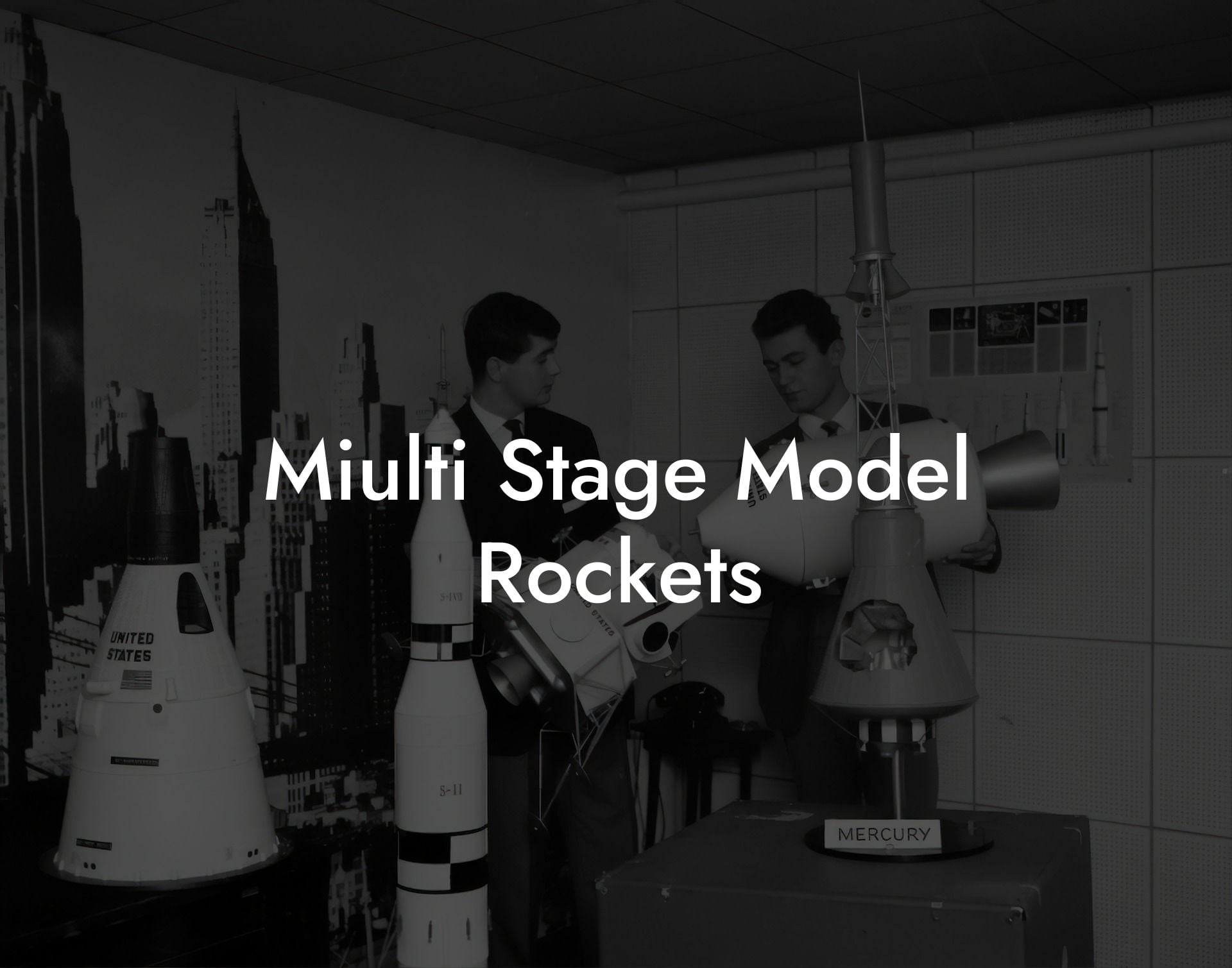Imagine soaring to new heights with a rocket that defies gravity and pushes the limits of innovation. Welcome to the world of multi-stage model rockets, where precision engineering meets artistic expression. Whether you're a seasoned enthusiast or a curious beginner, this comprehensive guide will propel you into the exciting realm of multi-stage model rocketry.
Quick Links to Useful Sections
- What Are Multi-Stage Model Rockets?
- The Anatomy of a Multi-Stage model rocket
- Designing and Building Your Multi-Stage Model Rocket
- Materials and Tools
- Design Considerations
- Assembly and Integration
- Launching and Recovering Your Multi-Stage Model Rocket
- Launch Site Selection
- Launch Procedures
- Recovery Techniques
- Tips and Tricks for Multi-Stage Model Rocketry
- Resources and Community Support: Your Next Steps
- Frequently Asked Questions: Multi-Stage Model Rocketry
What Are Multi-Stage Model Rockets?
Multi-stage model rockets are a type of model rocket that uses multiple stages to achieve higher altitudes and more efficient propulsion. Each stage is designed to burn out and separate from the previous one, allowing the rocket to shed weight and continue its ascent with increased speed and precision.
In simple terms, a multi-stage model rocket is like a high-performance sports car – it's designed to go fast, be efficient, and look amazing while doing it. With each stage, the rocket gains speed, altitude, and a sense of freedom that's hard to match.
Embracing the world of multi-stage model rockets means combining art, science, and imagination to create something truly remarkable. It's about pushing the boundaries of what's possible and exploring the thrill of flight.
The Anatomy of a Multi-Stage model rocket
A multi-stage model rocket consists of several key components, each designed to work in harmony to achieve a successful launch and recovery.
Looking For The Best Model Rocket Kits? You'll Love These:
- Boosters: The first stage of the rocket, responsible for lifting the vehicle off the launchpad and providing initial thrust.
- Sustainers: The second stage, which takes over once the booster has burned out, providing additional thrust and propelling the rocket to higher altitudes.
- Payload: The section of the rocket that carries the cargo, such as a camera, GPS tracker, or other scientific instruments.
- Recovery System: The parachute or other device that slows the rocket's descent, ensuring a safe and controlled recovery.
Understanding the anatomy of a multi-stage model rocket is crucial to designing, building, and launching a successful flight.
Designing and Building Your Multi-Stage Model Rocket
Building a multi-stage model rocket requires patience, skill, and attention to detail. From selecting the right materials to designing the perfect shape, every aspect of the rocket's construction plays a critical role in its performance.
Materials and Tools
The right materials and tools can make all the difference in building a successful multi-stage model rocket. From balsa wood to fiberglass, and from sandpaper to epoxy, understanding the strengths and weaknesses of each material is essential.
Design Considerations
A well-designed rocket is not just aesthetically pleasing – it's also critical to its performance. Considerations such as stability, aerodynamics, and weight distribution all play a crucial role in ensuring a successful flight.
Assembly and Integration
Assembling and integrating the various components of a multi-stage model rocket requires precision and attention to detail. From aligning the stages to connecting the electronics, every step of the process demands care and patience.
Launching and Recovering Your Multi-Stage Model Rocket
The moment of truth – launching and recovering your multi-stage model rocket is a thrilling experience that requires careful planning and execution.
Launch Site Selection
Choosing the right launch site is critical to a successful flight. Considerations such as wind direction, altitude, and obstacles all play a role in selecting the perfect location.
Launch Procedures
From setting up the launchpad to counting down to liftoff, every step of the launch procedure demands focus and attention to detail.
Recovery Techniques
Recovering your rocket safely and efficiently requires a combination of skill, patience, and the right equipment. From parachutes to GPS tracking, understanding the various recovery techniques is essential.
Tips and Tricks for Multi-Stage Model Rocketry
Whether you're a seasoned pro or just starting out, these tips and tricks will help you take your multi-stage model rocketry skills to the next level.
- Start Small: Begin with a simple single-stage rocket and gradually work your way up to more complex designs.
- Practice Makes Perfect: Don't be discouraged by failures – they're an essential part of the learning process.
- Join a community: Connecting with other model rocket enthusiasts can provide valuable insights, tips, and inspiration.
- Stay Safe: Always follow safety guidelines and best practices when launching and recovering your rocket.
By following these tips and tricks, you'll be well on your way to becoming a master of multi-stage model rocketry.
Resources and Community Support: Your Next Steps
The world of multi-stage model rocketry is vast and exciting, with a wealth of resources and community support available to help you on your journey.
- Online Forums: Join online forums and discussion groups to connect with other enthusiasts, ask questions, and share knowledge.
- Local Clubs: Find local model rocket clubs and organizations to meet like-minded individuals and learn from their experiences.
- Books and Guides: Explore a range of books, guides, and tutorials to improve your skills and stay up-to-date with the latest techniques.
- Competitions and Events: Participate in competitions and events to showcase your skills, learn from others, and be inspired by the community.
By tapping into these resources and community support, you'll be able to take your multi-stage model rocketry skills to new heights and stay inspired throughout your journey.
Frequently Asked Questions: Multi-Stage Model Rocketry
Here are some frequently asked questions about multi-stage model rocketry, answered by experts in the field.
1. What is the difference between a single-stage and multi-stage model rocket?
A single-stage model rocket uses a single motor to propel the vehicle, while a multi-stage model rocket uses multiple motors, each igniting in sequence to achieve higher altitudes and greater efficiency.
2. How do I choose the right materials for my multi-stage model rocket?
Consider factors such as weight, strength, and durability when selecting materials for your rocket. Balsa wood, fiberglass, and plastic are popular choices.
3. What is the best way to design a multi-stage model rocket?
A well-designed rocket should consider factors such as stability, aerodynamics, and weight distribution. Use software or online tools to simulate and optimize your design.
4. How do I assemble and integrate the components of my multi-stage model rocket?
Follow a step-by-step approach, carefully aligning and connecting the stages, electronics, and recovery system. Use adhesives, fasteners, and other materials as needed.
5. What safety precautions should I take when launching and recovering my multi-stage model rocket?
Always follow safety guidelines and best practices, including wearing protective gear, ensuring a safe launch site, and using a reliable recovery system.
Looking For The Best Model Rocket Kits? You'll Love These:
Useful Interruption: Dive deeper into the world of Model Rockets with our most popular sections. If there is anything you think is missing or anything you would love for us to write about, just give us a shout.
- Getting Started & Basics With Model Rockets
- Model Rocket Design, Build & Customization
- Model Rocket Propulsion & Engine Technology
- Model Rocket Launch Techniques & Recovery
- Model Rocket Advanced Rocketry & Innovations
- Model Rocket DIY and Customization
- Model Rocket Equipment Reviews & Digital Tools
- Community, Competitions & Education
- Model Rocket Troubleshooting & FAQs
- Model Rocket Bonus/Seasonal & Niche Topics
A group of model rocket enthusiasts gathered at a field for their weekly launch event. Among them was Dave, a seasoned builder known for pushing the limits of hobby rocketry. This time, he had outdone himself.
“Ladies and gentlemen,” Dave announced, dramatically pulling a cloth off his latest creation, “I present to you: The Kraken!”
The crowd gasped. This wasn’t just a model rocket, it was a monster. The thing stood 8 feet tall, had six clustered engines, and was covered in enough duct tape to qualify as a classified aerospace project.
“Dave,” muttered Steve, the cautious safety officer, “Have you, uh… done the math on this?”
“Math?” Dave scoffed. “I built it in my garage at 3 a.m. with parts from eBay. This is an art piece, Steve.”
The countdown began.
5…
4…
3…
2…
1…
The engines ignited with a BOOM, and The Kraken shot up… kind of. It immediately did a violent barrel roll, narrowly missing the spectators before skyrocketing at an angle that could only be described as “legally questionable.”
The crowd collectively ducked as The Kraken flew straight over the adjacent cornfield, where Old Man Jenkins, the grumpiest farmer in town, was minding his business.
KABOOM!
The rocket disappeared behind the barn. A moment later, a flaming piece of Estes igniter wire landed at Steve’s feet. The silence was deafening.
And then, an unmistakable sound echoed across the field.
Jenkins’ shotgun being cocked.
“DAVE!!!” Steve shouted. “RUN.”
And that was the day Dave invented the first-ever biologically powered rocket booster: pure adrenaline.
To this day, nobody knows where The Kraken landed, but legend has it, it still haunts the skies, terrifying unsuspecting drones and low-flying birds.















